Component parts and Assembly
Steering. Delete that annoying clicking when turning the S/wheel
Well the answer MIGHT be to go and buy a NEW W169 'A' Class or would it? I'll leave you to decide after reading this mail which I received from a not too happy owner:-
Quote
Hi Lofty
Thought you might be be interested in my experience with my local Mercedes Dealer. In October 2008 I bought a New A150 SE Automatic from Mercedes-Benz Brentford , a dealership owned by Mercedes-Benz.
I took my car in for its first service one year later after covering 4,000 miles and mentioned to the service assistant it had a knocking in the steering column, they rang me up later that day to tell me they would be fitting a new steering column and it would be off the road another day.
I got the car back and apart from having to take it back to have the steering wheel put on straight it seemed o.k.
Having only covered 1200 miles in the last nine months I was disappointed the knocking noise had come back.
I took my car back to Brentford and it was road tested by the workshop foreman who said the replacement steering column appeared to have failed, in fact he took the car into the workshop to have a look underneath it to make sure it was safe for me to use.
This morning I took my car into MB Brentford to have the steering column replaced and mentioned to the service assistant that on two occasions when I turned the ignition key the car had not started and he said they had a test for that and they would check it.
He rang me back at mid-day to tell me that they had taken my steering column off, and inspected it and it was defective and were replacing it with another new column which they had pre-ordered for my car, however on testing the starting system the starter motor was defective and they were ordering a new one which will not arrive until tomorrow morning.
I rang MB customer services and told them how unhappy I was with my car having had 2 replacement steering columns and a starter motor in 5,500 miles but they were not really interested.
I do not expect a reply from you as I am not asking you a question but wanted to let you know that the new W169 models still have the same steering problems/quality control issues.
Luckily for me as the car is still within the 3 year warrantee I am not paying for this work , just having the inconvenience of no car as they won't give me a loan car!
Fortunately as I bought the car under MB Agility the car is owned by MB and I get the choice of purchasing it when it is 3 years old, I think you can guess what my decision will be!
Unquote
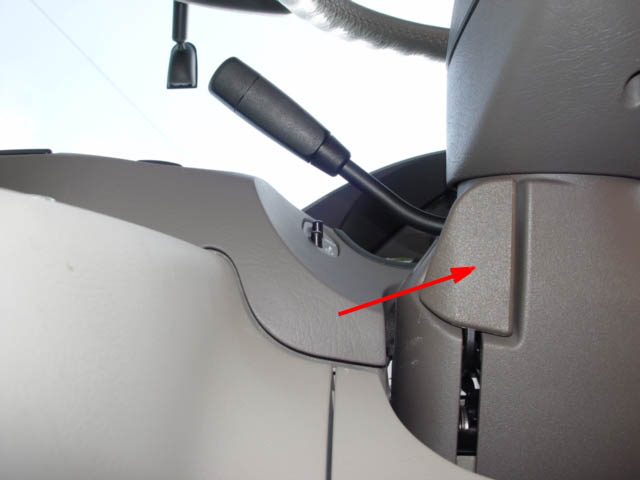 Steering Wheel Position Adjustment
Steering Wheel Position Adjustment
Please also read through page 50, before starting work on the steering assembly.
The steering wheel adjustment is one of the things I really like about the 'A' Class, in some makers cars the steering wheel is in your lap and others to high, in the A160 you have the choice of both and a bit in between.
The adjustment leaver/locking devise is to the left side of the steering column, above your left knee. Drop the leaver down and you are free to position the wheel where you want, within reason. Re-lock before moving off.
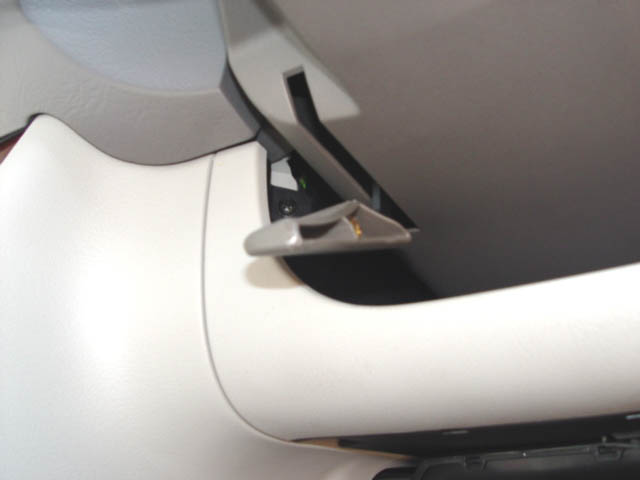
One word of warning if you ask another person to release your bonnet for you then and finish up doing it yourself because they couldn't locate the lever, check to see that they have not inadvertently released your steering wheel position lock, it can happen!
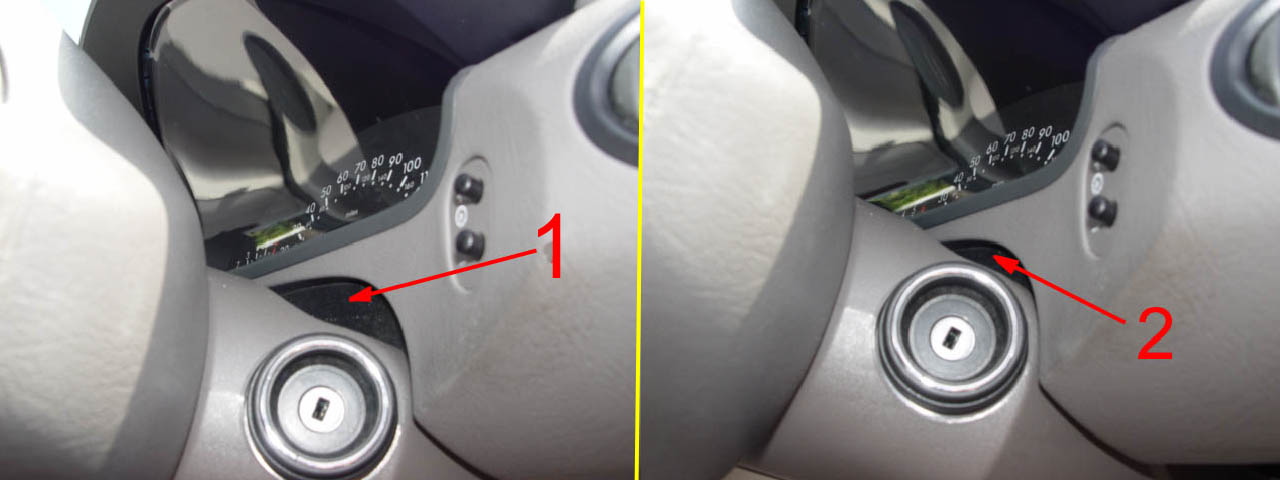
This picture shows the difference between the fully up & down positions, which although not a great amount makes the steering wheel position more comfortable for both short & tall drivers.
 29/06/2010 Driver/Owners of left hand drive 'A' Class
29/06/2010 Driver/Owners of left hand drive 'A' Class
The comments made below relate to the right hand drive car , the steering column having two UJ's Situated into it .
In the case of your car (LHD) these are not put under such stress as on the RHD model as the column and steering wheel are direct align with the steering rack.
However be aware of a defect that can arise, situated on your column is a plastic ring which cancels the indicators as the column is turned, this unit can fracture on both RHD & LHD and cause what appears to be a jammed/locked steering wheel even when moving, applying more pressure to straighten the steering wheel crushes this ring.
I have asked Jonas K the informant of this problem & driver of the car that suffered this serious defect which could have cost him his life that he should inform Mercedes-Benz of this problem, at present he is having problems even obtaining a new plastic ring, without purchasing the complete column, albeit the LHD column is a lot cheaper than RHD models
The example shown of the component on the right is for a W170 LHD model.
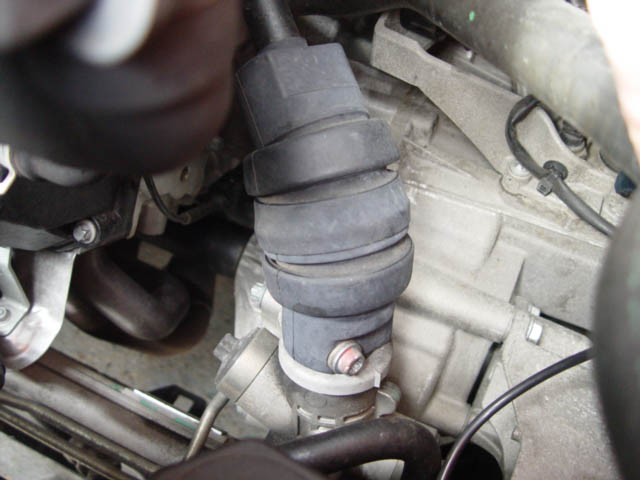 I think this component the Steering Column, is the most talked about on the baby-benz.com site, a great deal has been said about it, and it appears that it has been subject of many modifications over the relatively short life span of the 'A' Class. Many of the owners belonging to the club have had problems, some more than once, so this is an item which is worth keeping an eye on when you check your car for MOT as well as for general safety.
I think this component the Steering Column, is the most talked about on the baby-benz.com site, a great deal has been said about it, and it appears that it has been subject of many modifications over the relatively short life span of the 'A' Class. Many of the owners belonging to the club have had problems, some more than once, so this is an item which is worth keeping an eye on when you check your car for MOT as well as for general safety.
Following discussions with my MB agent I was surprised to hear that although the universal joint (UJ) is pre-packed with grease the component itself is in a dry condition within the rubber boot. There have been many cases of this component seizing , and sulphation forming on the components parts.
Steering column faults appear to fall into three categories :-
1:- steering wheel can be moved slightly up and down and slightly from side to side . The fault is caused by insufficient compression on the bearing at the bottom of the jacket tube, the upper tube/sleeve through which the column runs which allows play at the steering wheel
2 Slight clicking when you turn the steering wheel left, right, this is not a problem and should not cause the car to fail in any way, including the MOT .
However it is annoying and can be over come by greasing/packing the spline which runs between the middle and lower sections of the column.
See the information below.
I have applied heavy grease to the spline on several occasions and it cures the clicking for a while, so I'm confident that the cause of the clicking is minute movement in the spline.
The spline plays no part in the steering aspect of the car it simply allows the column to be split into two parts for removal purposes.
I contend that the theory about the column laying across the front of the engine to prevent the steering wheel hitting the driver when involved in a 'head on' collision/accident is rubbish, although I agree it may stop that happening, it wasn't in my view the reason it was fitted in that way.
If that was the case then left hand drive car would have the column laying in the other direction, which is not the case, as far as I can see it just saves Mercedes-Benz having to design two steering layouts , one for right hand drive car and one for left.
see below how to stop the annoying clicking
Mercedes-Benz workshops fit steering columns as though they grow on trees and there are instances of individual cars having had a number of columns fitted in a short space of time, at close on a £1000 time fitted that's no joke especially if you are the one paying the bill! Even if the car is under warrantee it is not always convenient to have to keep getting the car back to the agent for repairs or loosing for a couple of days while they repair you new car! And Mercedes-Benz, Head office in Germany still maintain there is no problem with the steering column. What a giggle
There are few owners who at some point do not have one or other of the above minor problems mentioned
If Mercedes want to change you column while the car is under warrantee, no problem they pay the bill. BUT if they tell you it needs replacing once the car is out of Warrantee and Murphy's law says it will want replacing at just outside the 3 year warrantee period that's a different story. It is unlikely that Mercedes will for instance want to grease the lower UJ but it will cure the problem, if you have got to the component before any real damage has been done, so check before committing 100s of £ for something that may not need to be replaced.
I for instance have had slight clicking on and off over two years, at no time has it been mentioned on the MOT, nor am I in any doubt that my steering is 100%
I cured this problem by packing the spline with thick grease which does stop the clicking for some time , however it does return after a while as the grease dissipates allowing the teeth on the spline to move fractionally when turning the steering wheel
I am now experimenting with another form of packing on the spline and the results have been 100% successful
How to stop the clicking,
Individual Owners must make up their own minds if they wish to follow my procedure, but be assured I would not have carried out any trial if I had felt that it in anyway compromised the safety of the car or was in anyway dangerous to the occupants.
New columns have been found to click as the steering is turned to and fro so it is not a wear problem, it is in my opinion a manufacturing, tolerance/fit of matched components problem.
On my own car I have now removed the lower section of the column from the wrack, and removed all the grease from the spline on both parts and cleaned with white spirit.
I have then placed a small blanking plug into the lower/hollow section, the same diameter as the tube. This I did because the lower section has a hole at the bottom of tube and I did not want the sealant coming into contact with the UJ assembly, albeit was unlikely as only a small amount was used.
I have then applied a small amount of silicone sealant, (Bath seal that remains flexible when cured was used as it could be easily removed had it not done the job) lower section and then reconnected the two parts, ensuring that the column is aligned correctly with the paint dots on the column, if yours is not marked, mark it before removing components. Also align your front wheels until the steering locks before starting, then remove key
Reconnect the column to the steering wrack tighten 'Torx' bolt to 20Nm
Allow the sealant to cure before trying the car, say an hour, better still over night.
I would be interested to hear how you get on and if it cures you clicking as it has mine.
I have only mentioned my intent to one owner, prior to posting my findings on this site who asked me to keep him informed of the trials, This was his reaction having carried out the same procedure following the total success on my own car:-
Quote.
Hi Lofty, just done the spline shaft on the steering, the noise stopped, its like driving a different car, what's the torque setting for the bolt on the UJ end as I just done it up tightish, Unquote
and Chris from Australia Quote I applied your "fix" to the steering shaft yesterday. I waited till today before testing the vehicle.
I can confirm that the clicking when turning is completely gone. After looking at your CD I also checked the bolts on the firewall and found them to be only finger tight, they have now been tightened as well.
So now the bushes, top strut mounts and drop links have been replaced. The vehicle is very quite to drive with no noticeable suspension noise, it does seem like a new car
again. Unquote
Results, As for my own car, after 12-15 months the clicking is just starting to come back ,so as soon as the weather is better I will repeat the procedure, very cheap and a definite cure.
However if the need arises for you to repeat this procedure you may have problems because of the snug fit and the adhesion of the sealant. To over come this problem simply pour boiling water on the outside of the column tube and then ease the tow parts apart it may take of couple of goes with the water but time is cheaper than a new column which may still produce the same problems after a very short service life.
3 A more serious problem is the ceasing of the lower UJ of the column cause by sulphation of the components and water ingress. I'm quite confident this water is somehow getting into the boot /gaiter when the windscreen washer bottle is filled, so take extra care when undertaking that task.
This is the Universal joint that connects the column to the steering wrack.
This again can be a problem in that the steering gets very stiff which causes some owners real concern, and rightly so.
This again is easily overcome if you get to it early enough, see the procedure below which simply involves easing back the protective gaiter, loosening off the joint with WD40 front wheels raised, and then when sufficiently freed off being given a good coating of GP grease to keep it free , the application of grease also helps to stop any moisture getting into the components of the UJ.
Warning
DO NOT BE Tempted in any circumstances to turn the steering wheel while the steering column is detached from the steering wrack, as this can cause serious damage to the Steering angle sensor (Clock spring) situated below the steering wheel
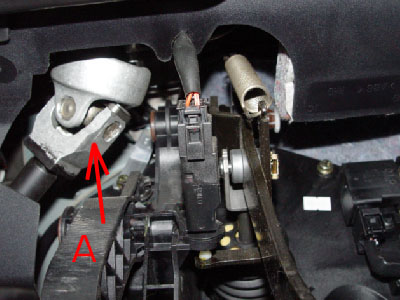
The UJ shown in this photo is located inside the vehicle and is therefore protected from the outside environment, unlike the one in the photo below which has been known to suffer from corrosion, sulphation and thus stiffening or seizing of the UJ. A is situated inside the car and therefore potentially protected from damp and road dirt. In view of the number of steering column problems the 'A' Class has suffered I surprised that this one also is not protected with a gaiter.
 When checking the steering column also check to see that the two nuts on the plastic housing located on the bulkhead are secure , although difficult to get at these nuts have been found to be loose on a number of cars. This problem has been highlighted by owners to me ,although I found mine to be tight.
When checking the steering column also check to see that the two nuts on the plastic housing located on the bulkhead are secure , although difficult to get at these nuts have been found to be loose on a number of cars. This problem has been highlighted by owners to me ,although I found mine to be tight.
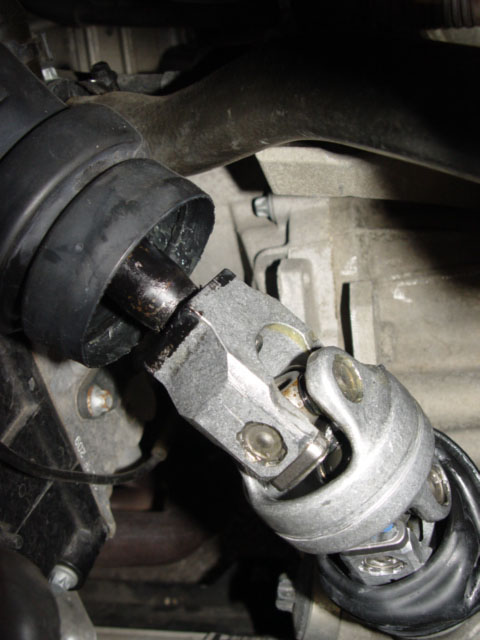 However if you already have problems, clicking, knocking or stiffness when turning the steering wheel, then you will need to take more dramatic action now if the column is to be salvaged. A new column with fitting will cost you £800-£900 something we would all like to avoid if possible.
However if you already have problems, clicking, knocking or stiffness when turning the steering wheel, then you will need to take more dramatic action now if the column is to be salvaged. A new column with fitting will cost you £800-£900 something we would all like to avoid if possible.
If your vehicle is still under warrantee then you would be well advised to seek the advise of MB before touching the UJ. This is only to avoid them saying that the column is not covered under the warrantee if problems do develop during that period.
Preventative action.

* Carefully separate the two half's of the 2 piece gaiter (boot), slide the top half away up the column away from the UJ fold the bottom half back down towards the rack.
* This will allow you to access the UJ and to enable you to spray with numerous bursts of WD40.L
* leave for a few minutes to allow this to penetrate the moving parts of the UJ
* Place papers or shiny magazines on the ground in front of the front wheels, and drive the car forward to position the car on them ( This action is to add turning the steering wheel without damaging the tyres on the solid surface and the prevent undue stress being placed on the other steering components.) Alternatively jack up the front of the car
* If jacking the front of the car up, then use jack's (two)under the suspension wish-bones, ensuring that the drive shaft's are as near horizontal as possible. See my comments reference drive shafts on page 29 With the engine running exercise the UJ by turning the steering wheel fully from left the right, several times or and until the UJ is fully freed off,
 * Switch off the engine, turn the steering wheel from left to right there should be no
* Switch off the engine, turn the steering wheel from left to right there should be no
stiffness at any point Bear in mind that with the engine off you do not have the assistance of power steering when turning the steering wheel.
.
* Having freed off the UJ service it using general purpose 'Molly' Grease' or a similar grease. get an assistant to slowly turn the steering wheel during application to ensure all parts of the UJ are coated/lubricated/protected.
 * Re-position the gaiters and wipe with a clean cloth.
* Re-position the gaiters and wipe with a clean cloth.
* I still fitted a plastic tie around the top half to ensure that water does not enter the UJ gaiter.
I am convinced that a number of the problems experienced with steering columns on this car is due to this UJ seizing, this places more pressure and wear on the other BUJ's on the column as well as the spine between the upper and lower sections of the column. Prevention has therefore got to be the best cure.
Replacement of gaiter/boot
This is not possible using MB parts as the gaiter/boot is not sold as a separate item. However if you column is sound in all other respects, then universal gaiters can be purchased and fitted to protect this item . Damage to this gaiter will not fail your car on the MOT in the UK. However the UJ does need protecting against salt water spray from our roads in winter as well as overspills from the screen wash bottle.
If you find a damaged/split Gaiter then ideally this should be replaced.
Although I have not had to undertake this repair on my own car others have, and so I will include the procedure.
Before disconnecting anything when undertaking repairs on your steering always check settings and column markers, the column is made of several inter connecting parts and so if removed or parts replaced they need to be replaced as found.
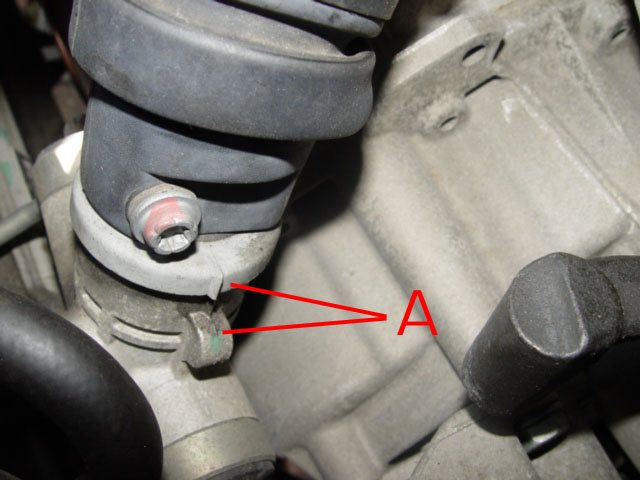
Align your steering using the markers on the steering rack , see photo A This action will ensure that components removed can be replaced in an identical position, I also chock the wheels.
Note the securing bolt is a 'T45' Torx drive
 On the column it is self there are paint spots, B
markers that should be aligned with one another, and should be in view when the rack markers are aligned. Having familiarised yourself with the location of the various components etc, unbolt and remove the UJ from the s/rack
On the column it is self there are paint spots, B
markers that should be aligned with one another, and should be in view when the rack markers are aligned. Having familiarised yourself with the location of the various components etc, unbolt and remove the UJ from the s/rack
Having first ensured the two halves of column are marked withdraw the lower shaft complete with UJ from the upper section of the steering column, this is done by sliding the lower shaft from the upper.
Remove the split/damaged gaiter,
The MB gaiter is made up of two parts, and so you will need to acquire a replacement that can be fitted in a similar way , the two parts interlocking to form a seal. Fit the upper portion of the new gaiter on to the lower section from the spline end with the open cup pointing towards the UJ/rack and slide part way down the shaft, a small amount of grease on the shaft will ensure the gaiter is not damaged, grease on the spline.
Replace the lower shaft back into the upper section , making sure that it is replace precisely aligned with the markers.
Place the lower half of the replacement gaiter on the UJ and position so as the align it with the bolt holes in the gaiter.
Re-secure the UJ to the rack ensuring that markers are aligned.
At this point take the opportunity to coat the UJ in grease ensuring that all moving parts are well coated, general purpose grease (GP) is Ok or if you only have Molly-slip or high melting point (HP) both of these will equally suffice. This action will help to prevent the UJ seizing and also retard any chance of corrosion and sulphation.
Note If on inspection you find the UJ stiff in its movement then give a good spray with WD40 and exercise it until it moves freely, if movement fully returns, grease and refit, if the unit is loose or showing signs of rust or corrosion then replace.
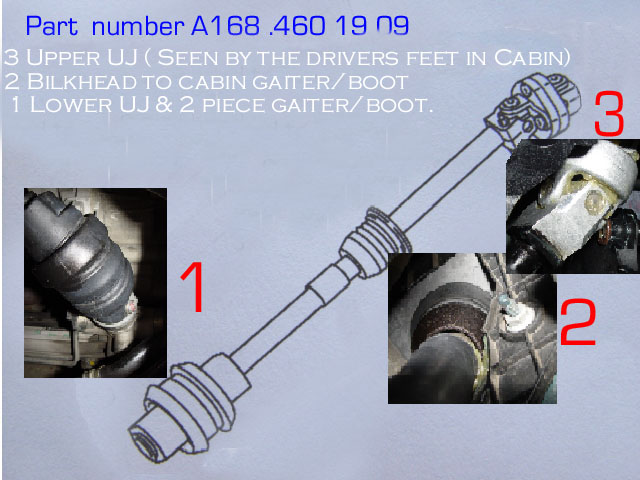 See note below
See note below
As of the 10/8/06 the main section of the column is available as a spare part. This includes the lower UJ, 2 piece rubber Boot/gaiter, the column sections that includes the sliding spline section up to the next UJ, which can be seen located by the clutch and brake peddles, the part number for this item is A168 460 19 09 and is priced at £157.79 plus vat 8/06
Note. My contact at my MB branch says this part is not now available separately from the main column , however it would be worth making inquiries at your branch before purchasing the complete column. A160 460 2216 (Adjustable) the current price of which 10/03/08 £364.00 Plus Vat.
Having serviced the UJ the open cups of the gaiter should now be facing towards one another, bring the two half cups together, the top cup goes over the lower cup.
This is how I would tackle it, but please remember I have not done the job! on my own car. But 'Macy' who has undertaken this task agrees with this basic procedures.
Where problems are experienced with the column on right drive cars the complete column will have to be replaced. Two units are available , adjustable ,and none adjustable , part number is reliant on chassis number and cost £227.11 & £282.65 respectively, both plus vat. plus fitting
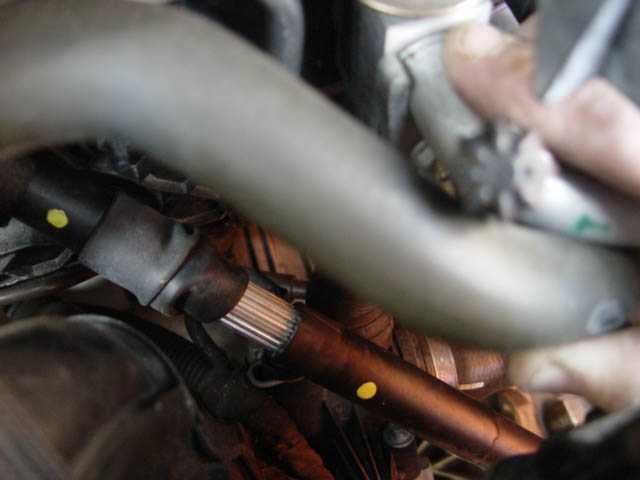
Between the upper and lower Universal joints
There is a telescopic section built into the shaft, the spline's engaging into the machined lower section of the shaft. This along with its 45% angle and location would allow the steering column to collapse in the event of a front impact accident thereby preventing the steering wheel from being pushed into the cabin and invariably the drivers chest. It is however Ironic that the column is not laid out in the same way on left hand drive cars? This joint also allows for the slight movement which takes place during every day driving, no matter how small.
It is interesting to note the two marks for re-positioning the two parts of the column. (Yellow painted dots) I have eased the rubber sheath back to enable us to see the spline. I was surprised to see that this spline was completely free of any form of lubricant, I personally consider that any moving part, no matter how slight should be lubricated, this is a steel component and it the right circumstances will rust , it will not then move in the way it should. I have therefore very lightly coated the exposed area of the spine with in general purpose grease, thus protecting & lubricating it. I would advise you to seek advice before doing the same, although I can see absolutely not reason why this should be a totally dry joint and lack of any lubricant can only increase the wear factor and deny the movement that is intended in it is design. This is just one e-mail I have received on this very subject:- Quote
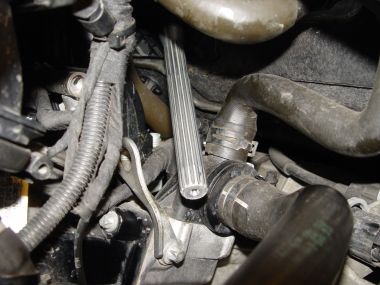

These two photographs show the sections of the main column the middle section being splined onto which the lower section slide, I have now proved conclusively that on my own car at least the clicking heard when the steering wheel is turned left, right, comes from the minute play on the spline, a good coating of thick grease will stop this annoying problem.
Hi, Can you help me out with a fault on the steering of my 1998 A160. The steering is OK for the first few miles then when everything is warmed up if I put a big input into the steering wheel it stiffens up, especially at low speeds. I thought it might be the pump on the way out but my local mechanic is going for a UJ fault. Its trying to track down the faulty item because all the components in the system are quite pricey. Your advice would be most appreciated.
Unquote
I responded to Andrew, suggesting that he follow my lubrication technique firstly spraying the UJ with plenty of WD40 which he did. I subsequently received this follow up e-mail:-
quote
Hi Lofty I put some WD40 into the gaiter on Monday before travelling 55 miles to work, no sign of any stiffness in the steering. At work I managed to get about half a pint of oil/grease mix into the gaiter and I have had no reoccurrence of the fault. Your diagnosis was spot on and has saved me a tidy sum of money. Thanks very much for your help and if I get any more problems I'll be straight onto your website. unquote
I do get great satisfaction from e-mails such as this where the owner is able to overcome a problem by common sense, something which is sadly left out of modern servicing techniques.
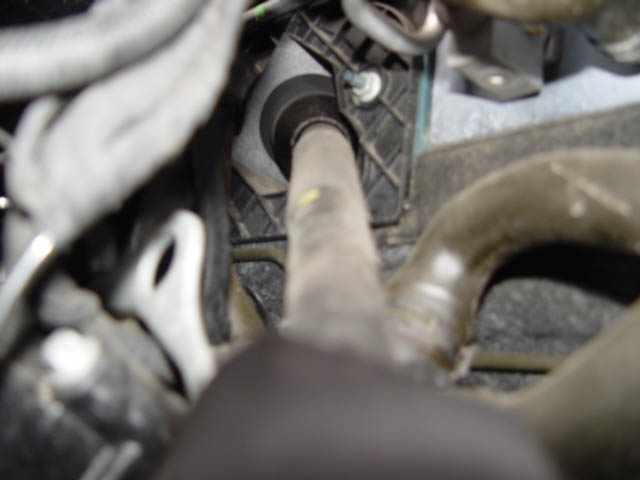 Checking for play in the steering column, one way to check is for one person to grip the UJ,(Universal Joint) the component hidden by the rubber gaiter and for the other to very lightly turn the steering wheel from left to right, several times . If there is wear in that joints or in the telescopic spline you should feel it, you may also hear a slight clicking.
Checking for play in the steering column, one way to check is for one person to grip the UJ,(Universal Joint) the component hidden by the rubber gaiter and for the other to very lightly turn the steering wheel from left to right, several times . If there is wear in that joints or in the telescopic spline you should feel it, you may also hear a slight clicking.
Again to check the UJ further up the column the shaft can be held firmly above the telescopic section, in the same way movement on the steering wheel will not immediately be felt at the column, if the joint is worn to any degree the steering wheel will turn without immediately moving the shaft. this check is carried out in much the same way as when checking ball joints. To reduce the tension on steering assembly and ball joints place two old shiny covered magazines on top of one another beneath each front wheel before starting your checks this will assist with the turning of the steering and will greatly reduce the force applied to the various components of the steering assembly and tyres.
Turning the steering wheel while the car is static is almost certainly one of the main contributors to steering column and steering component wear and should therefore be avoided whenever possible.
Even very slight motion when turning the wheels will over come the stress on components. Power steering although an asset, unfortunately enables even the weakest of people to turn the wheels while static. On cars with out power steering the amount of energy required to turn the wheels almost forces the driver to put the car into motion.
Breakdown of steering column

The Steering Rack
The Steering rack 1 lays horizontally level with the bottom of the engine, affixed to the rack are hydraulic high pressure hoses and rigid pipe work. 2 laying between the rack and the hoses can be seen the torsion bar. 3 to which the drop links are secured. Page 29.

Steering Rack and Hub Assembly.
Power Steering Pump Combined Reservoir NEW
If you have a defective power Steering pump (PSP) ECU Testing.com will now undertake the refurbishment of the pump for £195 less a discount if you mention this site 'Lofty's Homepage ) remember all of ECU testing's charged repairs comes with a long guarantee.
Please enclose details of the nature of the defect or communicate the problem when Phoning the company.
The power steering pump has a combined reservoir and is located on the N/S of the engine bay behind the radiator. Power Steering Pump, Combined Power assisted steering is provided by an electrically powered pump situated below the reservoir. My previous car had power steering which was powered from a drive belt running on a pulley from the engine, when started the power steering was active immediately. I have noticed with the 'A' Class that there is a delay of a few seconds before the power steering is active, although this does not present a problem.
With power steering which makes moving the steering so easy there is the temptation to turn the steering wheel without moving the car, this action puts a lot of pressure not just on the rack but also on steering ball joints as well as tyres, it is therefore good practice to always have to car moving, no matter how slow, when turning the steering wheel.
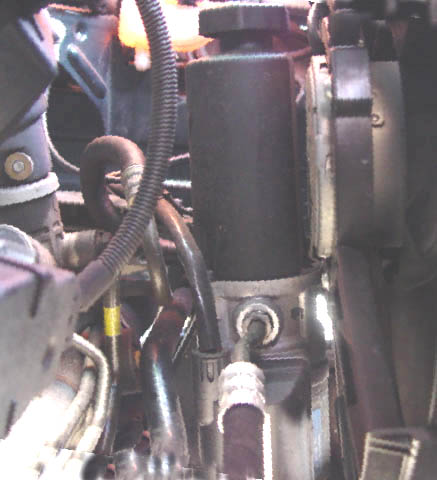
The PSP reservoir sits on the top of the electric pump that feeds the power steering rack. The system is sealed and therefore topping up of the fluid should not be necessary. However any drop in fluid level should be investigated as should heavy steering. The fluid levels should remain constant, if however seals are damaged or worn, like brakes fluid will seep. Mercedes Benz fluid Part number 001 989 24 03 applies. The power steering system holds 0.8 of a litre including pump.
In normal circumstances the reservoir will not need topping up, if this is the case use MB fluid and check the system for leaks before doing so.
MB also list 'Pentosin CHF 11S' as a suitable hydraulic fluid.
It is not recommended that fluids be mixed,
Shows the reservoir and power pack combined unit
Part No.A160/168 466 0410/0510, priced at £310 inclusive of Vat 01/08/07
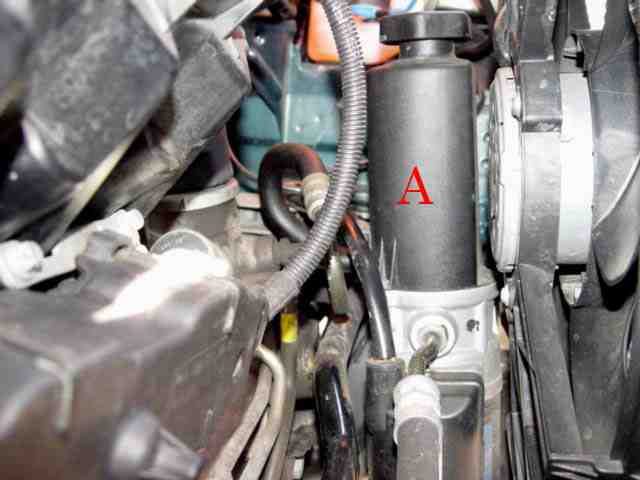
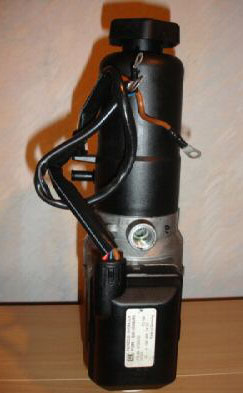
The power steering pump is now a repairable item for more details link on the pump.
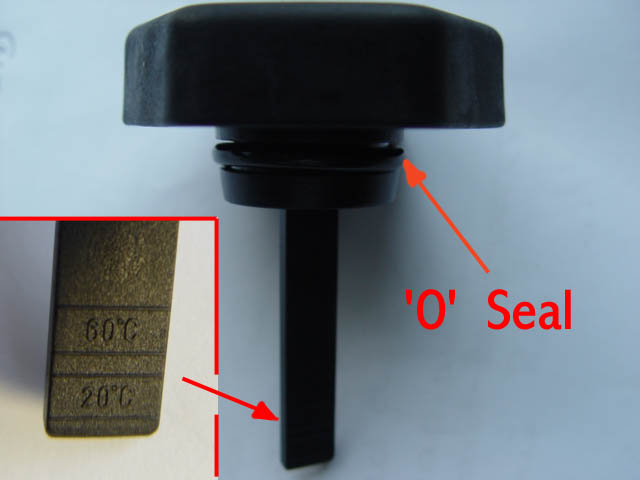
A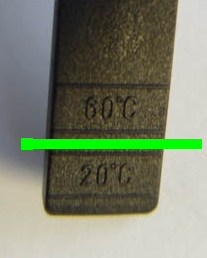 The reservoir has got a dip stick attached to the cap on which there are temperature markings at 20c approx the fluid level should be between the two level marks. Fluid should not exceed the marks when either hot or cold, over filling the system can cause over pressurisation of the system and cause seals and the system to be to be damaged.
The reservoir has got a dip stick attached to the cap on which there are temperature markings at 20c approx the fluid level should be between the two level marks. Fluid should not exceed the marks when either hot or cold, over filling the system can cause over pressurisation of the system and cause seals and the system to be to be damaged.
The green line indicates approx where you should see the fluid level when the fluid is cold. (car standing overnight.)
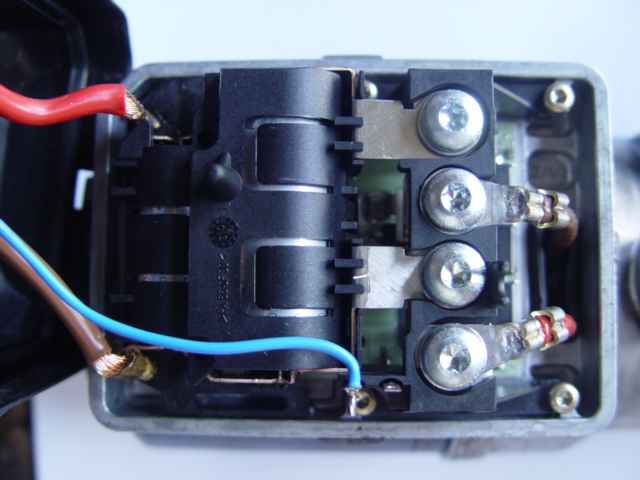 The pump is driven by a powerful electric motor situated on the bottom of the pump, these are the connection mounted on the unit, assembly.
The pump is driven by a powerful electric motor situated on the bottom of the pump, these are the connection mounted on the unit, assembly.
Although the operation of the system is a bit of a mystery , what have determined is that the pump will not run unless the alternator is generating power therefore if there is a fault on the alternator the power steering will cease to function. the blue wire shown in this photo has something to do with that arrangement.
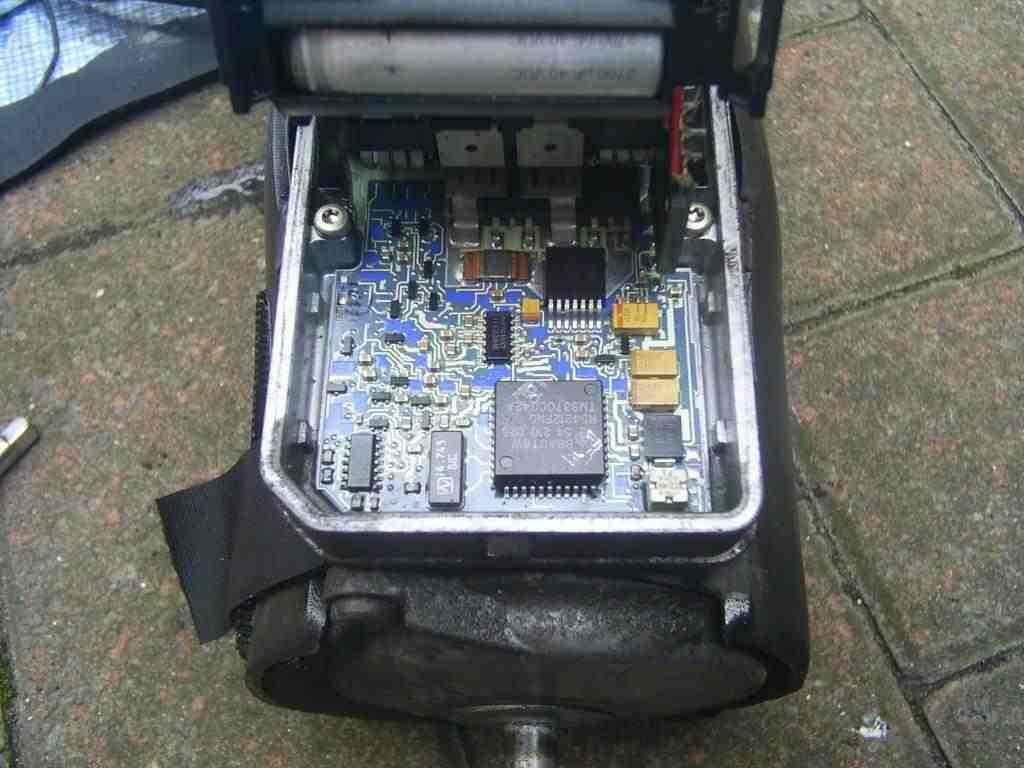
However if you thought the above was complex then look at this lot, this technology is beneath the above photo and forms part of the circuitry for the power steering system, as you can see there are several chips which are not going take kindly to being submerged in water so take care.
This PCB being housed in a none water tight box is only 6"off the ground so if the flood water comes much above the depth of your tyre walls then this box along with all in contains will be submerged in water, as a result there is every chance you will loose you power steering.(this photo by Nick)pump packed up as a result of the exposure to deep water, bear in mind also that that alternator is only a few inches higher off the ground. In Nicks case the pressure of water took part of the under tray off the car as well. So if you are intending driving through deep water as we have seen owners of various cars doing during the recent floods 07/07 then I suggest you trade the car in for a submarine!!
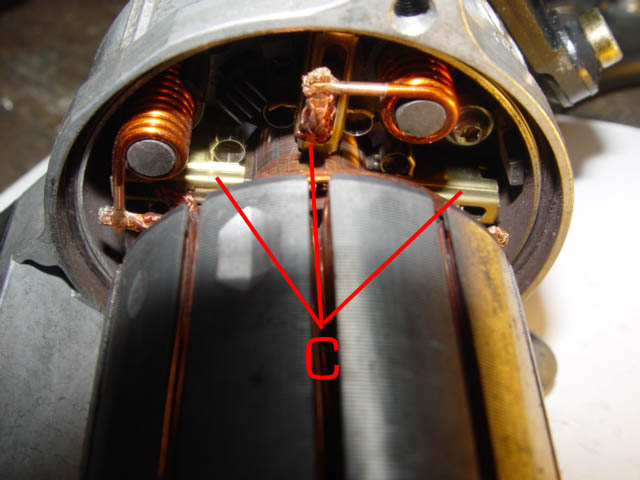 The motor is fitted with carbon brushes
C
which when worn will cause the electric motor to fail. I'm unsure as to where these can be obtained, however a good auto electrician should be able to supply and fit these for you.
The motor is fitted with carbon brushes
C
which when worn will cause the electric motor to fail. I'm unsure as to where these can be obtained, however a good auto electrician should be able to supply and fit these for you.
 There are 4 carbon brushes in this motor the brush carriers are the bright brass rectangular blocks
C
only three can be seen in the photograph above.
There are 4 carbon brushes in this motor the brush carriers are the bright brass rectangular blocks
C
only three can be seen in the photograph above.
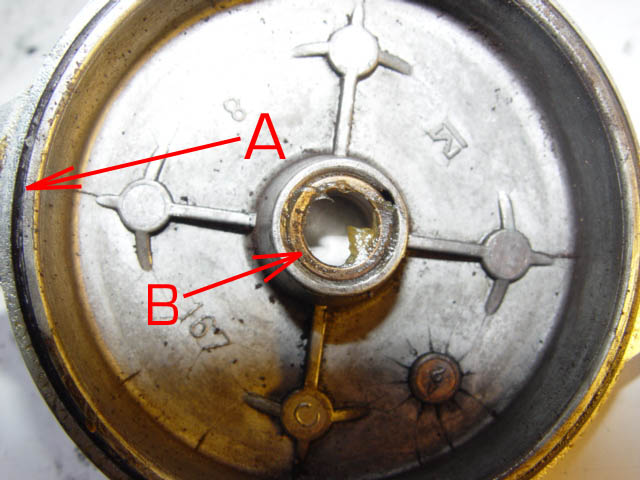
As can be seen this is a large motor, one of the reasons why it may stop if your alternator fails.
One reason for failure can be wear on the phosphorous bronze bearing B situated in the end cap which stabilises the armature in the motor. Again you should be able to obtain this from a good Auto electrician.
Note also the large 'O' Ring A which fits around the outer edge of the end cap forming a water tight seal.
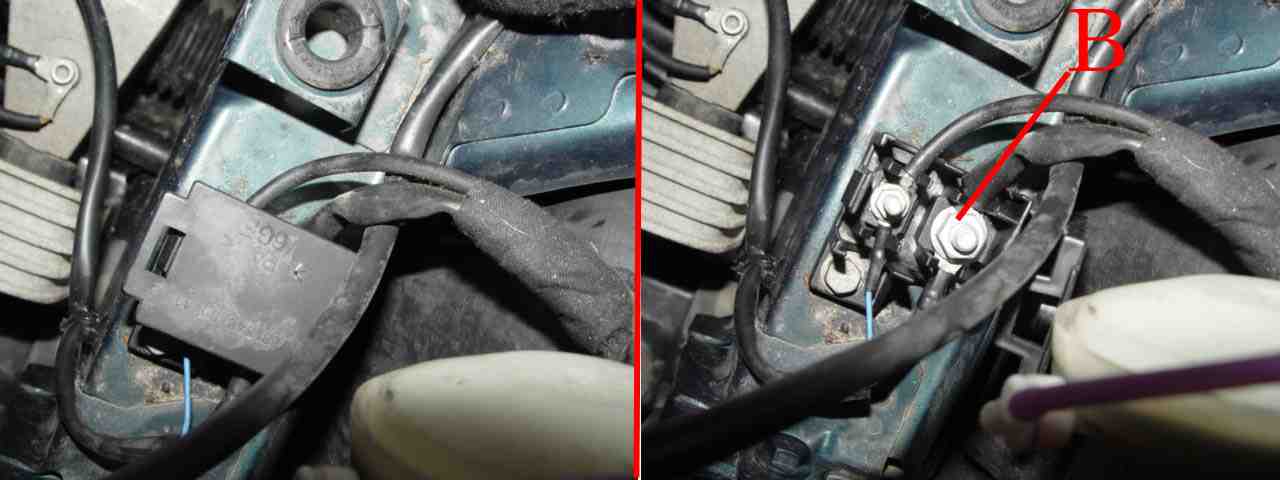
The electrical connections for the pump are located in a black plastic box, A with a flip up lid , located very near to the windscreen washer bottle support, on the top N/S sub frame. Ensure these are kept free of contamination at all times or your pump will fail
Power Steering pump Failure/Defects .
Breakdown of power steering pumps, yes there have been a few, and a new replacement from MB is expensive The type of breakdown falls mainly in to two categories,
One the pump continues to run even with the engine switched off, this is a real problem because if you do not hear the pump running then your battery will be flat in next to no time. ( in view of the fact that the pump is wired to only run when the alternator is producing power, I.e. engine running, indicates to me that the pump has a short circuit which is causing the pump circuits to remain live and therefore the pump to run continuously ) even with this defect the pump works normally when driving
The only way the pump can be stopped is to pull the large 60 amp fuse in position Number 47, replacing it when you intend driving.
so at least you will be able to get the vehicle home and pick up a spare part.
Feed back from one owner with this problem has confirmed that this is an electrical fault on the pump's complex electrical system, in his case after trying second hand pumps without success he fitted a new pump and has had no problem since.
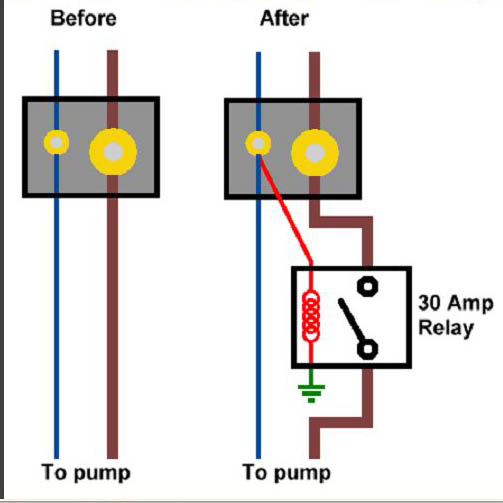
04/03/2010 Mike in New Zealand has now suffered the continuous running problem and has overcome the problem by fitting an inline relay. I will copy his mail here and you can then decide if you want to tackle the problem in the same way. Note this repair procedure will only cure the PSP continuous running problem not where the pump fails to run at all.
Quote
HiYa Lofty
I had a power steering pump fail on my 1999 A160 in that; the pump would continually run even with the ignition turned off.
Rather than spending NZ$2500 for a replacement I did the following:
1) Removed the blue and heavy current wire from the connector box.
2) Installed a generic 30Amp relay and attached the "trigger" between the blue wire and ground.
3) Passed the "heavy current" wire through the switching contacts of the relay to the pump.
This results in the pump coming on only after the engine has been started (and alternator providing current to the relay).
I have been using the car now with this mod for two weeks without any issues.
One day, I might remove the pump and give it a closer inspection and possibly an alternative repair solution.
Regards. Mike Unquote
Thanks Mike brilliant stuff.
The second of the defects is where the pump failed to run at all, check the 60amp fuse position 59 main fuse layout. Fuses are best tested with a meter which ensures they are sound if a reading is achieved. Test that power is being delivered to the pump via the blue wire which comes from the alternator. On my car with the pump working normally I get a reading of approx 12.5 volts on tick-over , with the ignition on but engine off I get a reading of approx 1.3 volts
If no power is received at the power-steering junction box n/s/front blue wire then check the connection onto the alternator, is is vital that possible defects on the alternator be discounted before considering the problem to be the PSP the pump does not run with ignition only ON, the alternator must be producing power in the blue wire. i.e. engine running .
At present I have no more information on either defect I will add it if and when any becomes available.
Even in the case of the failed pump the car can be driven with caution, But be aware that the steering will be very when compared to the normal situation, to overcome this in the short term extra pressure in the front tyres will help.
Next.
Back to Index,
Purchase DVD.
Please Make a Donation.
Quote
Hi Lofty
Thought you might be be interested in my experience with my local Mercedes Dealer. In October 2008 I bought a New A150 SE Automatic from Mercedes-Benz Brentford , a dealership owned by Mercedes-Benz.
I took my car in for its first service one year later after covering 4,000 miles and mentioned to the service assistant it had a knocking in the steering column, they rang me up later that day to tell me they would be fitting a new steering column and it would be off the road another day.
I got the car back and apart from having to take it back to have the steering wheel put on straight it seemed o.k.
Having only covered 1200 miles in the last nine months I was disappointed the knocking noise had come back.
I took my car back to Brentford and it was road tested by the workshop foreman who said the replacement steering column appeared to have failed, in fact he took the car into the workshop to have a look underneath it to make sure it was safe for me to use.
This morning I took my car into MB Brentford to have the steering column replaced and mentioned to the service assistant that on two occasions when I turned the ignition key the car had not started and he said they had a test for that and they would check it.
He rang me back at mid-day to tell me that they had taken my steering column off, and inspected it and it was defective and were replacing it with another new column which they had pre-ordered for my car, however on testing the starting system the starter motor was defective and they were ordering a new one which will not arrive until tomorrow morning.
I rang MB customer services and told them how unhappy I was with my car having had 2 replacement steering columns and a starter motor in 5,500 miles but they were not really interested.
I do not expect a reply from you as I am not asking you a question but wanted to let you know that the new W169 models still have the same steering problems/quality control issues.
Luckily for me as the car is still within the 3 year warrantee I am not paying for this work , just having the inconvenience of no car as they won't give me a loan car!
Fortunately as I bought the car under MB Agility the car is owned by MB and I get the choice of purchasing it when it is 3 years old, I think you can guess what my decision will be!
Unquote
Please also read through page 50, before starting work on the steering assembly.
The steering wheel adjustment is one of the things I really like about the 'A' Class, in some makers cars the steering wheel is in your lap and others to high, in the A160 you have the choice of both and a bit in between.
The adjustment leaver/locking devise is to the left side of the steering column, above your left knee. Drop the leaver down and you are free to position the wheel where you want, within reason. Re-lock before moving off.
One word of warning if you ask another person to release your bonnet for you then and finish up doing it yourself because they couldn't locate the lever, check to see that they have not inadvertently released your steering wheel position lock, it can happen!
This picture shows the difference between the fully up & down positions, which although not a great amount makes the steering wheel position more comfortable for both short & tall drivers.
The comments made below relate to the right hand drive car , the steering column having two UJ's Situated into it .
In the case of your car (LHD) these are not put under such stress as on the RHD model as the column and steering wheel are direct align with the steering rack.
However be aware of a defect that can arise, situated on your column is a plastic ring which cancels the indicators as the column is turned, this unit can fracture on both RHD & LHD and cause what appears to be a jammed/locked steering wheel even when moving, applying more pressure to straighten the steering wheel crushes this ring.
I have asked Jonas K the informant of this problem & driver of the car that suffered this serious defect which could have cost him his life that he should inform Mercedes-Benz of this problem, at present he is having problems even obtaining a new plastic ring, without purchasing the complete column, albeit the LHD column is a lot cheaper than RHD models
The example shown of the component on the right is for a W170 LHD model.
Following discussions with my MB agent I was surprised to hear that although the universal joint (UJ) is pre-packed with grease the component itself is in a dry condition within the rubber boot. There have been many cases of this component seizing , and sulphation forming on the components parts.
Steering column faults appear to fall into three categories :-
1:- steering wheel can be moved slightly up and down and slightly from side to side . The fault is caused by insufficient compression on the bearing at the bottom of the jacket tube, the upper tube/sleeve through which the column runs which allows play at the steering wheel
2 Slight clicking when you turn the steering wheel left, right, this is not a problem and should not cause the car to fail in any way, including the MOT .
However it is annoying and can be over come by greasing/packing the spline which runs between the middle and lower sections of the column.
See the information below.
I have applied heavy grease to the spline on several occasions and it cures the clicking for a while, so I'm confident that the cause of the clicking is minute movement in the spline.
The spline plays no part in the steering aspect of the car it simply allows the column to be split into two parts for removal purposes.
I contend that the theory about the column laying across the front of the engine to prevent the steering wheel hitting the driver when involved in a 'head on' collision/accident is rubbish, although I agree it may stop that happening, it wasn't in my view the reason it was fitted in that way.
If that was the case then left hand drive car would have the column laying in the other direction, which is not the case, as far as I can see it just saves Mercedes-Benz having to design two steering layouts , one for right hand drive car and one for left.
see below how to stop the annoying clicking
Mercedes-Benz workshops fit steering columns as though they grow on trees and there are instances of individual cars having had a number of columns fitted in a short space of time, at close on a £1000 time fitted that's no joke especially if you are the one paying the bill! Even if the car is under warrantee it is not always convenient to have to keep getting the car back to the agent for repairs or loosing for a couple of days while they repair you new car! And Mercedes-Benz, Head office in Germany still maintain there is no problem with the steering column. What a giggle
There are few owners who at some point do not have one or other of the above minor problems mentioned
If Mercedes want to change you column while the car is under warrantee, no problem they pay the bill. BUT if they tell you it needs replacing once the car is out of Warrantee and Murphy's law says it will want replacing at just outside the 3 year warrantee period that's a different story. It is unlikely that Mercedes will for instance want to grease the lower UJ but it will cure the problem, if you have got to the component before any real damage has been done, so check before committing 100s of £ for something that may not need to be replaced.
I for instance have had slight clicking on and off over two years, at no time has it been mentioned on the MOT, nor am I in any doubt that my steering is 100%
I cured this problem by packing the spline with thick grease which does stop the clicking for some time , however it does return after a while as the grease dissipates allowing the teeth on the spline to move fractionally when turning the steering wheel
I am now experimenting with another form of packing on the spline and the results have been 100% successful
How to stop the clicking,
Individual Owners must make up their own minds if they wish to follow my procedure, but be assured I would not have carried out any trial if I had felt that it in anyway compromised the safety of the car or was in anyway dangerous to the occupants.
New columns have been found to click as the steering is turned to and fro so it is not a wear problem, it is in my opinion a manufacturing, tolerance/fit of matched components problem.
On my own car I have now removed the lower section of the column from the wrack, and removed all the grease from the spline on both parts and cleaned with white spirit.
I have then placed a small blanking plug into the lower/hollow section, the same diameter as the tube. This I did because the lower section has a hole at the bottom of tube and I did not want the sealant coming into contact with the UJ assembly, albeit was unlikely as only a small amount was used.
I have then applied a small amount of silicone sealant, (Bath seal that remains flexible when cured was used as it could be easily removed had it not done the job) lower section and then reconnected the two parts, ensuring that the column is aligned correctly with the paint dots on the column, if yours is not marked, mark it before removing components. Also align your front wheels until the steering locks before starting, then remove key
Reconnect the column to the steering wrack tighten 'Torx' bolt to 20Nm
Allow the sealant to cure before trying the car, say an hour, better still over night.
I would be interested to hear how you get on and if it cures you clicking as it has mine.
I have only mentioned my intent to one owner, prior to posting my findings on this site who asked me to keep him informed of the trials, This was his reaction having carried out the same procedure following the total success on my own car:-
Quote.
Hi Lofty, just done the spline shaft on the steering, the noise stopped, its like driving a different car, what's the torque setting for the bolt on the UJ end as I just done it up tightish, Unquote
and Chris from Australia Quote I applied your "fix" to the steering shaft yesterday. I waited till today before testing the vehicle.
I can confirm that the clicking when turning is completely gone. After looking at your CD I also checked the bolts on the firewall and found them to be only finger tight, they have now been tightened as well.
So now the bushes, top strut mounts and drop links have been replaced. The vehicle is very quite to drive with no noticeable suspension noise, it does seem like a new car
again. Unquote
Results, As for my own car, after 12-15 months the clicking is just starting to come back ,so as soon as the weather is better I will repeat the procedure, very cheap and a definite cure.
However if the need arises for you to repeat this procedure you may have problems because of the snug fit and the adhesion of the sealant. To over come this problem simply pour boiling water on the outside of the column tube and then ease the tow parts apart it may take of couple of goes with the water but time is cheaper than a new column which may still produce the same problems after a very short service life.
3 A more serious problem is the ceasing of the lower UJ of the column cause by sulphation of the components and water ingress. I'm quite confident this water is somehow getting into the boot /gaiter when the windscreen washer bottle is filled, so take extra care when undertaking that task.
This is the Universal joint that connects the column to the steering wrack.
This again can be a problem in that the steering gets very stiff which causes some owners real concern, and rightly so.
This again is easily overcome if you get to it early enough, see the procedure below which simply involves easing back the protective gaiter, loosening off the joint with WD40 front wheels raised, and then when sufficiently freed off being given a good coating of GP grease to keep it free , the application of grease also helps to stop any moisture getting into the components of the UJ.
Warning
DO NOT BE Tempted in any circumstances to turn the steering wheel while the steering column is detached from the steering wrack, as this can cause serious damage to the Steering angle sensor (Clock spring) situated below the steering wheel
The UJ shown in this photo is located inside the vehicle and is therefore protected from the outside environment, unlike the one in the photo below which has been known to suffer from corrosion, sulphation and thus stiffening or seizing of the UJ. A is situated inside the car and therefore potentially protected from damp and road dirt. In view of the number of steering column problems the 'A' Class has suffered I surprised that this one also is not protected with a gaiter.
If your vehicle is still under warrantee then you would be well advised to seek the advise of MB before touching the UJ. This is only to avoid them saying that the column is not covered under the warrantee if problems do develop during that period.
Preventative action.

* Carefully separate the two half's of the 2 piece gaiter (boot), slide the top half away up the column away from the UJ fold the bottom half back down towards the rack.
* This will allow you to access the UJ and to enable you to spray with numerous bursts of WD40.L
* leave for a few minutes to allow this to penetrate the moving parts of the UJ
* Place papers or shiny magazines on the ground in front of the front wheels, and drive the car forward to position the car on them ( This action is to add turning the steering wheel without damaging the tyres on the solid surface and the prevent undue stress being placed on the other steering components.) Alternatively jack up the front of the car
* If jacking the front of the car up, then use jack's (two)under the suspension wish-bones, ensuring that the drive shaft's are as near horizontal as possible. See my comments reference drive shafts on page 29 With the engine running exercise the UJ by turning the steering wheel fully from left the right, several times or and until the UJ is fully freed off,
stiffness at any point Bear in mind that with the engine off you do not have the assistance of power steering when turning the steering wheel.
.
* Having freed off the UJ service it using general purpose 'Molly' Grease' or a similar grease. get an assistant to slowly turn the steering wheel during application to ensure all parts of the UJ are coated/lubricated/protected.
* I still fitted a plastic tie around the top half to ensure that water does not enter the UJ gaiter.
I am convinced that a number of the problems experienced with steering columns on this car is due to this UJ seizing, this places more pressure and wear on the other BUJ's on the column as well as the spine between the upper and lower sections of the column. Prevention has therefore got to be the best cure.
Replacement of gaiter/boot
This is not possible using MB parts as the gaiter/boot is not sold as a separate item. However if you column is sound in all other respects, then universal gaiters can be purchased and fitted to protect this item . Damage to this gaiter will not fail your car on the MOT in the UK. However the UJ does need protecting against salt water spray from our roads in winter as well as overspills from the screen wash bottle.
If you find a damaged/split Gaiter then ideally this should be replaced.
Although I have not had to undertake this repair on my own car others have, and so I will include the procedure.
Before disconnecting anything when undertaking repairs on your steering always check settings and column markers, the column is made of several inter connecting parts and so if removed or parts replaced they need to be replaced as found.
Align your steering using the markers on the steering rack , see photo A This action will ensure that components removed can be replaced in an identical position, I also chock the wheels.
Note the securing bolt is a 'T45' Torx drive
Having first ensured the two halves of column are marked withdraw the lower shaft complete with UJ from the upper section of the steering column, this is done by sliding the lower shaft from the upper.
Remove the split/damaged gaiter,
The MB gaiter is made up of two parts, and so you will need to acquire a replacement that can be fitted in a similar way , the two parts interlocking to form a seal. Fit the upper portion of the new gaiter on to the lower section from the spline end with the open cup pointing towards the UJ/rack and slide part way down the shaft, a small amount of grease on the shaft will ensure the gaiter is not damaged, grease on the spline.
Replace the lower shaft back into the upper section , making sure that it is replace precisely aligned with the markers.
Place the lower half of the replacement gaiter on the UJ and position so as the align it with the bolt holes in the gaiter.
Re-secure the UJ to the rack ensuring that markers are aligned.
At this point take the opportunity to coat the UJ in grease ensuring that all moving parts are well coated, general purpose grease (GP) is Ok or if you only have Molly-slip or high melting point (HP) both of these will equally suffice. This action will help to prevent the UJ seizing and also retard any chance of corrosion and sulphation.
Note If on inspection you find the UJ stiff in its movement then give a good spray with WD40 and exercise it until it moves freely, if movement fully returns, grease and refit, if the unit is loose or showing signs of rust or corrosion then replace.
As of the 10/8/06 the main section of the column is available as a spare part. This includes the lower UJ, 2 piece rubber Boot/gaiter, the column sections that includes the sliding spline section up to the next UJ, which can be seen located by the clutch and brake peddles, the part number for this item is A168 460 19 09 and is priced at £157.79 plus vat 8/06
Note. My contact at my MB branch says this part is not now available separately from the main column , however it would be worth making inquiries at your branch before purchasing the complete column. A160 460 2216 (Adjustable) the current price of which 10/03/08 £364.00 Plus Vat.
Having serviced the UJ the open cups of the gaiter should now be facing towards one another, bring the two half cups together, the top cup goes over the lower cup.
This is how I would tackle it, but please remember I have not done the job! on my own car. But 'Macy' who has undertaken this task agrees with this basic procedures.
Where problems are experienced with the column on right drive cars the complete column will have to be replaced. Two units are available , adjustable ,and none adjustable , part number is reliant on chassis number and cost £227.11 & £282.65 respectively, both plus vat. plus fitting
Between the upper and lower Universal joints
There is a telescopic section built into the shaft, the spline's engaging into the machined lower section of the shaft. This along with its 45% angle and location would allow the steering column to collapse in the event of a front impact accident thereby preventing the steering wheel from being pushed into the cabin and invariably the drivers chest. It is however Ironic that the column is not laid out in the same way on left hand drive cars? This joint also allows for the slight movement which takes place during every day driving, no matter how small.
It is interesting to note the two marks for re-positioning the two parts of the column. (Yellow painted dots) I have eased the rubber sheath back to enable us to see the spline. I was surprised to see that this spline was completely free of any form of lubricant, I personally consider that any moving part, no matter how slight should be lubricated, this is a steel component and it the right circumstances will rust , it will not then move in the way it should. I have therefore very lightly coated the exposed area of the spine with in general purpose grease, thus protecting & lubricating it. I would advise you to seek advice before doing the same, although I can see absolutely not reason why this should be a totally dry joint and lack of any lubricant can only increase the wear factor and deny the movement that is intended in it is design. This is just one e-mail I have received on this very subject:- Quote
These two photographs show the sections of the main column the middle section being splined onto which the lower section slide, I have now proved conclusively that on my own car at least the clicking heard when the steering wheel is turned left, right, comes from the minute play on the spline, a good coating of thick grease will stop this annoying problem.
Hi, Can you help me out with a fault on the steering of my 1998 A160. The steering is OK for the first few miles then when everything is warmed up if I put a big input into the steering wheel it stiffens up, especially at low speeds. I thought it might be the pump on the way out but my local mechanic is going for a UJ fault. Its trying to track down the faulty item because all the components in the system are quite pricey. Your advice would be most appreciated.
Unquote
I responded to Andrew, suggesting that he follow my lubrication technique firstly spraying the UJ with plenty of WD40 which he did. I subsequently received this follow up e-mail:-
quote
Hi Lofty I put some WD40 into the gaiter on Monday before travelling 55 miles to work, no sign of any stiffness in the steering. At work I managed to get about half a pint of oil/grease mix into the gaiter and I have had no reoccurrence of the fault. Your diagnosis was spot on and has saved me a tidy sum of money. Thanks very much for your help and if I get any more problems I'll be straight onto your website. unquote
I do get great satisfaction from e-mails such as this where the owner is able to overcome a problem by common sense, something which is sadly left out of modern servicing techniques.
Again to check the UJ further up the column the shaft can be held firmly above the telescopic section, in the same way movement on the steering wheel will not immediately be felt at the column, if the joint is worn to any degree the steering wheel will turn without immediately moving the shaft. this check is carried out in much the same way as when checking ball joints. To reduce the tension on steering assembly and ball joints place two old shiny covered magazines on top of one another beneath each front wheel before starting your checks this will assist with the turning of the steering and will greatly reduce the force applied to the various components of the steering assembly and tyres.
Turning the steering wheel while the car is static is almost certainly one of the main contributors to steering column and steering component wear and should therefore be avoided whenever possible.
Even very slight motion when turning the wheels will over come the stress on components. Power steering although an asset, unfortunately enables even the weakest of people to turn the wheels while static. On cars with out power steering the amount of energy required to turn the wheels almost forces the driver to put the car into motion.
Breakdown of steering column
The Steering Rack
The Steering rack 1 lays horizontally level with the bottom of the engine, affixed to the rack are hydraulic high pressure hoses and rigid pipe work. 2 laying between the rack and the hoses can be seen the torsion bar. 3 to which the drop links are secured. Page 29.
Steering Rack and Hub Assembly.
Power Steering Pump Combined Reservoir NEW
If you have a defective power Steering pump (PSP) ECU Testing.com will now undertake the refurbishment of the pump for £195 less a discount if you mention this site 'Lofty's Homepage ) remember all of ECU testing's charged repairs comes with a long guarantee.
Please enclose details of the nature of the defect or communicate the problem when Phoning the company.
The power steering pump has a combined reservoir and is located on the N/S of the engine bay behind the radiator. Power Steering Pump, Combined Power assisted steering is provided by an electrically powered pump situated below the reservoir. My previous car had power steering which was powered from a drive belt running on a pulley from the engine, when started the power steering was active immediately. I have noticed with the 'A' Class that there is a delay of a few seconds before the power steering is active, although this does not present a problem.
With power steering which makes moving the steering so easy there is the temptation to turn the steering wheel without moving the car, this action puts a lot of pressure not just on the rack but also on steering ball joints as well as tyres, it is therefore good practice to always have to car moving, no matter how slow, when turning the steering wheel.
The PSP reservoir sits on the top of the electric pump that feeds the power steering rack. The system is sealed and therefore topping up of the fluid should not be necessary. However any drop in fluid level should be investigated as should heavy steering. The fluid levels should remain constant, if however seals are damaged or worn, like brakes fluid will seep. Mercedes Benz fluid Part number 001 989 24 03 applies. The power steering system holds 0.8 of a litre including pump.
In normal circumstances the reservoir will not need topping up, if this is the case use MB fluid and check the system for leaks before doing so.
MB also list 'Pentosin CHF 11S' as a suitable hydraulic fluid.
It is not recommended that fluids be mixed,
Shows the reservoir and power pack combined unit
Part No.A160/168 466 0410/0510, priced at £310 inclusive of Vat 01/08/07

The power steering pump is now a repairable item for more details link on the pump.
A
 The reservoir has got a dip stick attached to the cap on which there are temperature markings at 20c approx the fluid level should be between the two level marks. Fluid should not exceed the marks when either hot or cold, over filling the system can cause over pressurisation of the system and cause seals and the system to be to be damaged.
The reservoir has got a dip stick attached to the cap on which there are temperature markings at 20c approx the fluid level should be between the two level marks. Fluid should not exceed the marks when either hot or cold, over filling the system can cause over pressurisation of the system and cause seals and the system to be to be damaged.The green line indicates approx where you should see the fluid level when the fluid is cold. (car standing overnight.)
Although the operation of the system is a bit of a mystery , what have determined is that the pump will not run unless the alternator is generating power therefore if there is a fault on the alternator the power steering will cease to function. the blue wire shown in this photo has something to do with that arrangement.

However if you thought the above was complex then look at this lot, this technology is beneath the above photo and forms part of the circuitry for the power steering system, as you can see there are several chips which are not going take kindly to being submerged in water so take care.
This PCB being housed in a none water tight box is only 6"off the ground so if the flood water comes much above the depth of your tyre walls then this box along with all in contains will be submerged in water, as a result there is every chance you will loose you power steering.(this photo by Nick)pump packed up as a result of the exposure to deep water, bear in mind also that that alternator is only a few inches higher off the ground. In Nicks case the pressure of water took part of the under tray off the car as well. So if you are intending driving through deep water as we have seen owners of various cars doing during the recent floods 07/07 then I suggest you trade the car in for a submarine!!
As can be seen this is a large motor, one of the reasons why it may stop if your alternator fails.
One reason for failure can be wear on the phosphorous bronze bearing B situated in the end cap which stabilises the armature in the motor. Again you should be able to obtain this from a good Auto electrician.
Note also the large 'O' Ring A which fits around the outer edge of the end cap forming a water tight seal.
The electrical connections for the pump are located in a black plastic box, A with a flip up lid , located very near to the windscreen washer bottle support, on the top N/S sub frame. Ensure these are kept free of contamination at all times or your pump will fail
Power Steering pump Failure/Defects .
Breakdown of power steering pumps, yes there have been a few, and a new replacement from MB is expensive The type of breakdown falls mainly in to two categories,
One the pump continues to run even with the engine switched off, this is a real problem because if you do not hear the pump running then your battery will be flat in next to no time. ( in view of the fact that the pump is wired to only run when the alternator is producing power, I.e. engine running, indicates to me that the pump has a short circuit which is causing the pump circuits to remain live and therefore the pump to run continuously ) even with this defect the pump works normally when driving
The only way the pump can be stopped is to pull the large 60 amp fuse in position Number 47, replacing it when you intend driving.
so at least you will be able to get the vehicle home and pick up a spare part.
Feed back from one owner with this problem has confirmed that this is an electrical fault on the pump's complex electrical system, in his case after trying second hand pumps without success he fitted a new pump and has had no problem since.

04/03/2010 Mike in New Zealand has now suffered the continuous running problem and has overcome the problem by fitting an inline relay. I will copy his mail here and you can then decide if you want to tackle the problem in the same way. Note this repair procedure will only cure the PSP continuous running problem not where the pump fails to run at all.
Quote
HiYa Lofty
I had a power steering pump fail on my 1999 A160 in that; the pump would continually run even with the ignition turned off.
Rather than spending NZ$2500 for a replacement I did the following:
1) Removed the blue and heavy current wire from the connector box.
2) Installed a generic 30Amp relay and attached the "trigger" between the blue wire and ground.
3) Passed the "heavy current" wire through the switching contacts of the relay to the pump.
This results in the pump coming on only after the engine has been started (and alternator providing current to the relay).
I have been using the car now with this mod for two weeks without any issues.
One day, I might remove the pump and give it a closer inspection and possibly an alternative repair solution.
Regards. Mike Unquote
Thanks Mike brilliant stuff.
The second of the defects is where the pump failed to run at all, check the 60amp fuse position 59 main fuse layout. Fuses are best tested with a meter which ensures they are sound if a reading is achieved. Test that power is being delivered to the pump via the blue wire which comes from the alternator. On my car with the pump working normally I get a reading of approx 12.5 volts on tick-over , with the ignition on but engine off I get a reading of approx 1.3 volts
If no power is received at the power-steering junction box n/s/front blue wire then check the connection onto the alternator, is is vital that possible defects on the alternator be discounted before considering the problem to be the PSP the pump does not run with ignition only ON, the alternator must be producing power in the blue wire. i.e. engine running .
At present I have no more information on either defect I will add it if and when any becomes available.
Even in the case of the failed pump the car can be driven with caution, But be aware that the steering will be very when compared to the normal situation, to overcome this in the short term extra pressure in the front tyres will help.
Next.
Back to Index,
Purchase DVD.
Please Make a Donation.